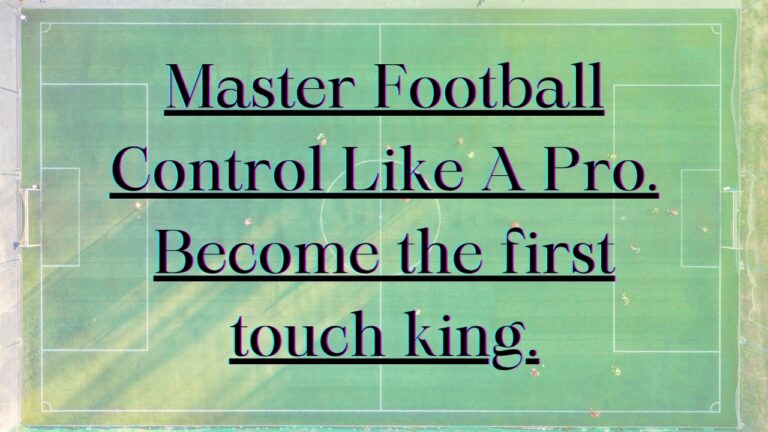What is a Box-to-Box Midfielder?
A box-to-box midfielder is a versatile central midfielder in soccer who is expected to contribute at both ends of the pitch. As the name suggests, they are required to cover the entire area from their own “box” or penalty area to the opponent’s.
Unlike defensive midfielders who sit back and protect the defense or attacking midfielders who focus on creativity and goalscoring, the box-to-box mid has a more complete skill set and must be adept at both defending and attacking. They link play from the backline to the forwards, supporting their teammates on both sides of the ball.
On the field, box-to-box midfielders often play alongside a holding mid or as part of a midfield trio. They have a huge engine, exceptional stamina, and the fitness to constantly join the attack after fulfilling their defensive duties. Their typical positioning is as a central mid in a 4-4-2, 4-3-3, 4-5-1, or similar system.
Key Attributes and Traits of Successful Box-to-Box Midfielders
To succeed as a box-to-box midfielder requires a diverse set of well-rounded attributes:
Technical skills; high competency in core skills like passing, shooting, crossing, dribbling, first touch, etc. They must be able to contribute to goals and assists regularly.
Tremendous stamina; having the fitness and work rate to cover 7-10 km per match; supporting play at both ends non-stop.
Defensive abilities; strong tackling, pressing, and reading of the game to break up attacks. Positioning and tactical discipline are also crucial.
Attacking drive; ability to make surging runs forward with and without the ball. Pose an aerial and long-shot threat.
Game intelligence; excellent reading of space, patterns of play, and opponent movements. High soccer IQ.
Leadership; communication, organization, and motivation of teammates. Often a captain or leader.
Some standout examples of box-to-box midfielders include Steven Gerrard, Frank Lampard, Bastian Schweinsteiger, Yaya Toure, and Paul Scholes.
Related Post: How to Become a Better-Attacking Midfielder in Soccer
Famous and Successful Box-to-Box Midfielders Throughout History
The box-to-box midfield role has been embodied by some of the greatest legends of the game through many eras:
Frank Lampard (Chelsea, England) is one of the most prolific goal-scoring midfielders ever, with 211 goals for Chelsea. Exceptional lateness runs into the box. Premier League record of 164 consecutive appearances in midfield.
Steven Gerrard (Liverpool, England): Heartbeat of Liverpool and England for 17 years with sublime long passing and long-range shooting. Scored 120 goals from midfield along with 92 assists.
Lothar Matthäus (Bayern Munich, Germany): Captained West Germany to a 1990 World Cup triumph. Complete midfield package – tackling, shooting, passing, and leadership. FIFA World Player of the Year 1991.
Zinedine Zidane (Juventus, Real Madrid, France): a graceful playmaker who was surging box-to-box presence earlier in his career before playing higher up at Real. His volley in the 2002 Champions League Final is iconic.
Roy Keane (Manchester United, Ireland): Fierce competitor and dominant box-to-box figure for 12 years at United. Driving force behind their Treble win in 1999 with his intensity and leadership.
This is just a snapshot of some of the legendary box-to-box midfielders who defined generations with their exploits. The very best combined sublime technical qualities with fitness, passion, and intelligence to control matches from box to box.
The Evolution of the Box-to-Box Midfield Role
The interpretation of the box-to-box midfield role has evolved over the decades as tactics and systems in soccer have developed.
– In the 1950s-60s, midfielders were more structured into defined positions. The central midfield duo would share duties side-by-side with one deeper and one more attacking.
– In the 1970s, total football made midfielders more fluid and dynamic. Dutch legend Johan Cruyff epitomized the box-to-box style as part of Ajax and Holland’s free-flowing soccer.
– The 4-4-2 became prominent in the 1980s-90s which suited box-to-box midfielders. Battles between famous pairs like Keane vs. Vieira defined the era.
– From the 2000s, formations have shifted to only one or two central mids. Specialized holding mids now cover defense more.
– Modern box-to-box midfielders have taken on even more attacking responsibilities, almost like hybrid midfield/forward roles.
While once expected to balance attack and defense equally, contemporary box-to-box players have a license to push forward more with defensive duties covered by others. However, elite stamina and work rates are still in demand.
Related Post: How to Become a Better-Attacking Midfielder in Soccer
The Importance of Box-to-Box Midfielders in Modern Soccer
Despite evolutions in tactics, the box-to-box midfielder remains a vital component in the modern game:
– Provide crucial defensive protection, allowing other midfielders and fullbacks to roam forward.
– Turnover possession high up the pitch to immediately threaten the opposition goal.
– Supply the main creative forces by recycling possessions efficiently.
– Crucial in transitions from defending to attacking with their ability to carry the ball upfield rapidly.
– Pose a significant goal threat with late runs into the box and long-range shooting ability.
– Offer managers tactical flexibility, as they can play multiple roles in midfield effectively.
The very best teams still rely on at least one quality box-to-box midfielder to set the tempo, dominate the heart of the pitch, and contribute at both ends. Players like Kevin De Bruyne, Toni Kroos, and Paul Pogba demonstrate their enduring importance.
While systems and formations may evolve, there will always be a need for players who can influence matches from box to box with their tireless running and completeness.
To End
The Enduring Importance of Box-to-Box Midfielders
Box-to-box midfielders have been a crucial ingredient in successful soccer teams for generations. From the eras of Matthäus and Gerrard to modern stars like Pogba and De Bruyne, their versatility and completeness have made them invaluable.
While the specific interpretation of their role has evolved over the decades, the box-to-box player remains vital in linking play, providing defensive cover, supporting attacks, and controlling midfield. Their high fitness levels and well-rounded attributes allow them to dominate matches from start to finish.
Moving forward, the box-to-box midfielder will continue adapting to tactical innovations, taking on more specialized duties. However, their ability to defend tenaciously, attack dynamically, and cover every blade of grass will ensure their place among the most important positions in soccer.
The elite box-to-box players combine technical qualities with tremendous engines to drive their teams forward. While managers may utilize them in different ways, this complete midfield profile will always have a crucial place in the beautiful game.
Related Post: How to Become a Better-Attacking Midfielder in Soccer




